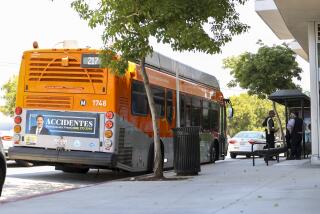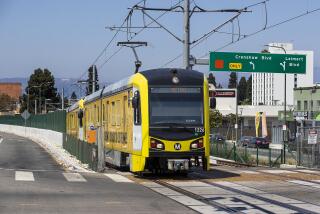Electric Buses Touted as Quick Fix for Gridlock : Rapid transit: The ‘trackless trolleys’ have many supporters, but one of them acknowledges that they ‘all have hidden agendas’ for promoting the vehicles, which rely on overhead wires.
- Share via
In most American cities, electric buses--which draw power from a maze of overhead wires--are viewed as a transportation technology whose best days are behind it.
But in the San Fernando Valley, the so-called “trackless trolleys” have demonstrated unexpected staying power, at least as a proposed quick fix for gridlocked streets.
In the past year, electric buses, long a fixture in San Francisco, Seattle, Boston and Dayton, Ohio, have been suggested for several east-west Valley thoroughfares. And a preliminary study has concluded that trackless trolleys might work on Victory Boulevard to speed up east-west traffic in the south Valley.
Proponents focus on the two major environmental advantages electric buses have over their diesel cousins--they create almost no noise or odors.
They also accelerate slightly faster than diesel-powered buses, devotees say.
However, the overhead wires, which run parallel to the route and are supported at intervals by cables crossing the street, are acknowledged to be a tough sell in a Valley peopled with well-organized and wary homeowners.
In fact, most transportation planners don’t seem to know how seriously to take the persistent, low-volume discussion in the Valley of electric buses.
Doubts creep in because almost everyone promoting the buses seems to have an ulterior motive.
Some are longtime opponents of rail projects and seem more interested in heading off construction of the recently approved cross-Valley rail line. Others seem to want to use the electric buses to focus attention on rail routes that lost out in the competition for approval by the Los Angeles County Transportation Commission.
And skeptics wonder what is behind the willingness of the Southern California Rapid Transit District to study an alternative technology such as trackless trolleys.
Some believe the RTD, which recently completed a preliminary report on “electrifying” Victory and parts of Topanga Canyon and Lankershim boulevards, is searching for a new technology out of frustration at losing control of the Metro Rail subway to its archrival, the County Transportation Commission.
“Sure we all have hidden agendas,” said RTD Director Nick Patsaouras, a Tarzana resident who recently emerged as a leading advocate of electric buses. “But that doesn’t mean they are not an idea that should be looked into.”
Also feeding skepticism is the fact that trackless trolleys have been fading from American cities for nearly a half-century. Industry sources say that many cities have removed them since World War II--usually in favor of light-rail lines, which are faster and have a higher passenger capacity but also are much more expensive. And no American city is presently considering installing them, although San Francisco is expanding its network.
By most accounts, the first public official to advocate trackless trolleys in the Valley was state Sen. Alan Robbins (D-Tarzana), who did so last summer while looking for ways to gain support for his preferred rail plan.
Robbins suggested temporarily operating electric buses on a six-mile stretch of the Southern Pacific railroad freight right of way between North Hollywood and the San Diego Freeway. It was the same route he supported for a rail line and the one ultimately approved by the County Transportation Commission for a westward extension of the downtown-to-North Hollywood Metro Rail subway.
Robbins and Los Angeles City Councilman Marvin Braude were architects of the coalition of business, civic and homeowner group leaders that successfully campaigned for a subway along the Southern Pacific route, which roughly parallels Chandler and Victory boulevards. Formation of the coalition broke what appeared to be a deadlock on the issue.
Many homeowners backed the Robbins-Braude plan only because they preferred it to two other commission proposals for a cross-Valley system--a ground-level line along the Southern Pacific route or an elevated line along the Ventura Freeway--that would bring noise and ground vibrations to their neighborhoods.
Business leaders, who maintain that an east-west rail line is needed immediately so that gridlock does not harm the local economy, joined the coalition reluctantly, noting that a subway would cost far more than a ground-level system and that construction would likely be delayed until funds were available.
The County Transportation Commission projects that the Metro Rail extension will be completed in 2001, the same year that the subway is expected to reach North Hollywood from downtown.
Robbins said in a recent interview that the trackless trolley plan was a “way to make the long wait more palatable.”
But he also contended that electric buses “could be a way to build ridership along the route, so that when rail is finished people will already be used to using public transportation.”
Another early advocate of electric buses was Gerald A. Silver, president of Homeowners of Encino, who has proposed electrifying Ventura Boulevard from Universal City to Woodland Hills.
Silver, a militant opponent of all rail systems proposed for Los Angeles, contends the lines are too costly to build and never meet ridership projections.
He said that his support for electric buses has grown “at about the same rate that I’ve become disillusioned with these costly rail systems, based on their dismal performance elsewhere.”
Silver predicts homeowner groups along Ventura Boulevard eventually will support electric buses as an environmentally preferred alternative to the diesel buses that plow up and down the boulevard.
By 1996, when construction is to start on the westward extension of Metro Rail, Silver hopes that rail advocates will “come to see that rail is a horrible waste of money, and that electric buses are a sensible alternative,” he said.
Patsaouras, who organized an April 7 brainstorming session at which 32 Valley leaders proposed short-term solutions to congestion, also thinks electrifying Ventura Boulevard might be a good idea.
But Patsaouras acknowledges that he is hoping that studying the boulevard will focus attention on the heavy traffic along the south Valley thoroughfare--which he advocates as a subway route in lieu of the Robbins-Braude plan to utilize the Southern Pacific railroad right of way.
The RTD director said he “wouldn’t be surprised if studying Ventura Boulevard for electric buses” leads planners to look more seriously at the boulevard for a rail line.
“Even though the other route has been adopted, I’m still hoping they will see that Ventura Boulevard is the place to build the subway,” Patsaouras said.
Gary Spivack, RTD assistant general manager, said that his staff recently estimated the cost of electrifying a 21-mile route from Universal City to Chatsworth at $43 million--as opposed to $200 million a mile for a subway line.
The proposed electric bus route would follow Lankershim, Victory and Topanga Canyon boulevards.
A drawback is that because freeways cannot be electrified, Valley passengers headed over the Cahuenga Pass would have to change to diesel buses at Universal City, he said.
“But our preliminary look didn’t turn up any special problems that would prevent using such a system,” Spivack said.
Overhead lines likely would encounter resistance, Spivack said, but he recalls from his youth in Philadelphia that “after a while, you don’t notice them anymore.”
Spivack said he would present the results, along with other proposals for expanding diesel bus service, to the next Valley transportation session, which Patsaouras is organizing.
The prospect of cleaner air is often cited in Valley discussions of electric buses. But the nationwide drive to reduce air pollution has not triggered a rush to electrify bus routes, said Mike Hodge, an administrator for New Flyer Corp. of Winnipeg, Canada, the only North American manufacturer of trackless trolleys.
“We’ve had no inquiries at all from United States cities, although I kind of expected some with the new pollution laws,” he said in a telephone interview.
“Of course, the systems remain popular in Canada and Europe. And San Francisco seems to love them.”
San Francisco’s romance with electric buses goes back more than 40 years and shows no signs of waning, said Johnny Stein, general manager of the San Francisco Municipal Railway. Stein’s agency operates 104 miles of trackless trolleys, which is about one-sixth of the total route-miles served by city buses. Transit officials recently sought bids to electrify an additional 20 miles.
“People here love them because diesel buses are such bad neighbors,” he said, adding that on San Francisco’s steep hills, everything bad about diesels is magnified.
“After you experience the noise and fumes of a diesel engine on a steep hill, the wire maze doesn’t look so terrible,” Stein said.
More to Read
Sign up for Essential California
The most important California stories and recommendations in your inbox every morning.
You may occasionally receive promotional content from the Los Angeles Times.










